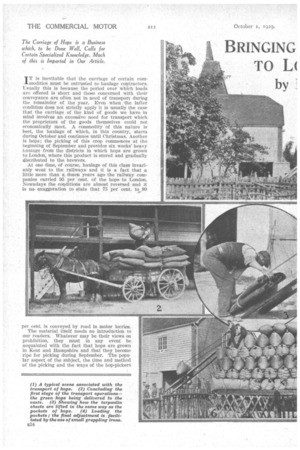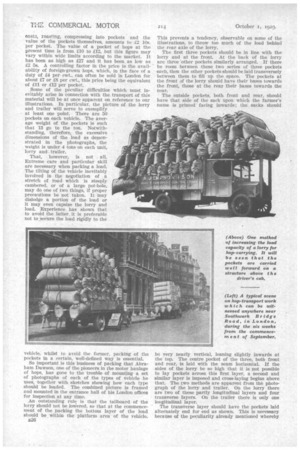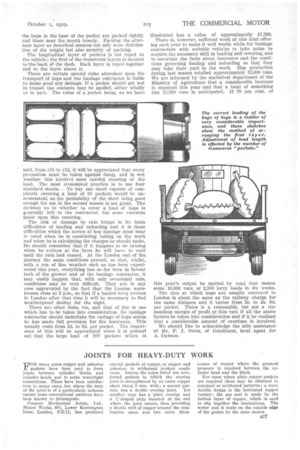The Carriage of Hops is a Business which, to be
Page 58

Page 59

Page 60

Page 61

If you've noticed an error in this article please click here to report it so we can fix it.
Done Well, Calls for Certain Specialized Knowledge. Much of this is Imparted in Our Article.
IT is inevitable that the carriage of certain commodities must be entrusted to haulage contractors. Usually this is because the period over which loads are offered is short and those concerned with their conveyance are often not in need of transport during the remainder of the year. Even when the latter condition does not strictly apply it is usually the case that the carriage of the kind of goods we have in mind involves an excessive need for transport which the proprietors of the goods themselves could not economically meet. A commodity of this nature is beet, the haulage of which, in this country, starts during October and continues until Christmas. Another is hops; the picking of this crop commences at the beginning of September and provides six weeks' heavy haulage from the districts in which hops are grown to London, where this product is stored and gradually distributed to the brewers.
At one time, of course, haulage of this class invariably went to the railways and it is a fact that a little more than a dozen years ago the railway companies carried 95 per cent, of the hops to London. Nowadays the conditions are almost reversed and it is no exaggeration to state that 75 per cent. to... SO
per cent, is conveyed by road in motor lorries.
The material itself needs no introduction to our readers. Whatever may be their views on prohibition, they must in any event be acquainted with the fact that hops are grown in Kent and Hampshire and that they become ripe for picking during September. The popular aspect of the subject, the time and method of the picking and the ways of the hop-pickers are invariably discussed at length in the daily newspapers about this time of the year. Certain details of interest, however, are not usually enlarged upon by newspaper reporters.
The hops, as they are picked, are thrown into large canvas bins, each party of pickers having its own bin. They are transferred thence to sacks and the quantities are checked by bushel measure, the pickers being paid at the rate of approximately 1s. per five or six bushels. Each sack holds about ten bushels and the sacks of hops when filled are called "pokes.' The pokes are carried from the gardens to the oasts by horsedrawn lorry, motor vehicles being used but rarely for this purpose and then only when the ground is hard, "
The green hops are placed in oasts where they. are roasted for a period of from 8 hours to 12 hours. They are then withdrawn from the oasts and spread about the floor of an adjoining chamber. The text process is the packing of the hops into "pockets." This packing is done by manually operated presses and to such effect that, notwithstaading the almost feathery nature of the product, each pocket—a sack about 2 ' ft. in diameter and 7 ft. tall—weighs complete.approximately
11 cwt. There is .a peculiarity about this packing which has a bearing on the cartage of the hops. The packing of the material near the mouth of the sack is not so tight as that of the remainder, the. object being to allow freedom to extract samples from • near the mouth.
It is estimated that the total, cost of all .the foregoing processeg, picking, cartage to the oasts, roasting, compressing into pockets and the value of the pockets themselves, amounts to 12 10s. per pocket. The value of a pocket of hops at the present time is from 110 to £12, but this figure may vary within wide limits according to the market. It has been as high as £27 and it has been as low as £2 5s. A controlling factor in the price is the availability of foreign-grown hops, which, in the face of a duty of £4 per cwt., can often be sold in London for about £7 or £8 per cwt., this price being the equivalent of £11 or £12 per pocket.
That, however, is not all. Extreme care and particular skill are necessary when packing a load. The tilting of the vehicle inevitably involved in the negotiation of a stretch of road which is steeply cambered, or of a large pot-hole, may do one of two things, if proper precautions be not taken. It may dislodge a portion of the load or it may even capsize the lorry and load. Experience has shown that to avoid the latter, it is preferable not to secure the load rigidly to the vehicle, whilst to avoid the former, packing of the pockets in a certain, well-defined way is essential. So important is this business of packing that Abraham Dawson, one of the pioneers in the motor haulage of hops, has gone to the trouble of mounting a set of photographs of each of the types of vehicle he uses, together with sketches showing how each type should be loaded. The combined picture is framed and mounted in the entrance hall of his London offices for inspection at any time. An outstanding rule is that the tailboard of the lorry should not be lowered, so that at the commencement of the packing the bottom layer of the load should be within the platform area of the vehicle. B26 This prevents a tendency, observable on some of the illustrations, to throw too much of the load behind the rear axle of the lorry. The first three pockets should he in line with the lorry and at the front. At the back of the lorry are three other pockets similarly arranged. If there be room between these two series of three pockets each, then the other pockets should be laid transversely between them to fill up the space. The pockets at the front of the lorry should have their bases towards the front, those at the rear their bases towards the rear.
The outside pockets, both front and rear, should have that side of the sack upon which the farmer's name is printed facing inwards; the sacks should be very nearly vertical, leaning slightly inwards at the top. The centre pocket of the three, both front and rear, is laid with the seam horizontal. If the sides of the lorry be so high that it is not possible to lay pockets across this first layer, a second and similar layer is imposed and cross-laying begins above that. The two methods are apparent from the photograph of the lorry and trailer. On the lorry there are two of these partly longitudinal layers and four transverse layers. On the trailer there is only one longitudinal layer.
The transverse layer, .should have the pockets laid alternately end for end as shown. This is necessary because a the peculiarity already mentioned whereby
the hops in the base of the pocket are packed tightly and those near the mouth loosely. Packing the alternate layer as described ensures not only even distribution of the weight but also security of packing.
The longitudinal layer of pockets is not roped to the 'vehicle; the first of the transverse layers is secured to he back of the dash. Each layer is roped together and to the layer above it.
There are certain special risks attendant upon the transport-Of hops and the haulage contractor is liable to make good any damage. If a pocket should get wet in transit the contents may be spolled, either wholly or in part. The value of a pocket being, as we have
said, from 110 to E2, it will be appreciated that every precaution must .be taken against damp, and in wet weather this InVolves Most careful sheeting of the load. . The most ecOnomical practice is to use four standard sheets. To buy one sheet capable of completely. covering a load of 50 pockets would be uneconomical, as.the probability of the sheet being good enough for use in the second season is not great. The decision • as to whether to cover a .load of hops is generally 'left to the contractor, but some concerns insist upon this covering.
The risk of damage by rain brings in its train difficulties of loading and unloading and it is these difficulties which the novice at hop haulage must bear in mind when he is considering taking on the work and when he is calculating the charges he should make. He should remember that if it happens to be raining when he arrives at the farm he will have to wait until the rain had ceased. At the London end of the journey the same conditions prevail, so that, whilst, with a run of fine weather such as has been experienced this year, everything has so far been in favour both of the grower and of the haulage contractor, it may easily happen that,' with only occasional rain, conditions may be very difficult. They are in any ease aggravated by the fact that the London warehouses close at 5 p.m., so that if a loaded lorry arrives in London after that time it will he necessary to find weatherproof shelter for the night.
There arc other risks, too, and that of fire is one which has to be taken into consideration. No haulage contractor should undertake the cartage of hops unless he has made full provision for fire insurance. This usually costs from 2d. to 3d. per pocket. The importance of this will be appreciated when it is pointed out that the large load of 100 pockets which is illustrated has a value of approximately .£1,200.
There is, however, sufficient work of this kind offering each year to make it well worth while for haulage contractors with suitable vehicles to take pains to acquire the necessary skill in loading and covering, and to ascertain the facts about insurance and the conditions governing loading and unloading so that they may take their part in the work. Hop production during last Season totalled approximately 12,000 tons. We are informed by the statistical department of the Ministry of Agriculture that a considerable increase is expected this year and that a total of something like 15,500 tons is anticipated. If 70 per cent. of this year's output be carried by road that means some 10,000 tons, or 2,500 lorry loads in six weeks.
The rate at which hops are usually conveyed to London is about the same as the railway charge for the same distance and it varies from 2s. to 2s. ed. per pocket. There is a reasonable, but not a tremendous margin of profit at this rate if all the above factors be taken into consideration and if it be realized that a considerable amount of overtime is involved.
We should like to acknowledge the able assistance of Mr. F. J. Owen, of Goudhurst, local agent for A. Dawson.






















































































































